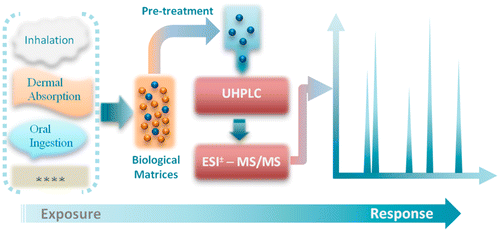Testing for secondhand marijuana exposure

With increased legalization of marijuana for medicinal and recreational purposes, interest is growing in the potential health effects of its secondhand smoke. A team now reports in ACS' journal Analytical Chemistry the development of a urine screening method that is sensitive enough to detect even small amounts of chemicals that result from this exposure.
Current drug tests can detect large amounts of the psychoactive marijuana component tetrahydrocannabinol (THC) and its metabolites in urine. That's sufficient when testing whether a potential employee or professional athlete has used the drug. But in the case of secondhand marijuana smoke, the levels of these substances in the urine are too low to be flagged, so it's difficult to assess whether this type of exposure could cause harmful health effects. As a first step toward investigating the effect of secondhand marijuana smoke exposure, Binnian Wei and colleagues at the U.S. Centers for Disease Control and Prevention sought to develop a more sensitive urine test for cannabinoids.
The researchers combined ultrahigh performance liquid chromatography and tandem mass spectrometry with positive electrospray ionization mode to develop a reliable, fast and accurate method to test for THC and its metabolites. The approach is 10 to 100 times more sensitive than current methods. In laboratory tests, the method detected the substances at levels approximating those that would be in the urine of someone exposed to secondhand marijuana smoke. Because the method is semi-automated, it could be used for large-scale population studies.
More information: Binnian Wei et al. Analysis of Cannabinoids and Their Metabolites in Human Urine, Analytical Chemistry (2015). DOI: 10.1021/acs.analchem.5b02603
Abstract
Biologically monitoring marijuana exposure from active and passive use requires both a wide linear range and sensitive detection. We have developed and validated a multifunctional method using ultrahigh performance liquid chromatography coupled with tandem mass spectrometry (UHPLC–MS/MS) for analysis of urinary Δ9-tetrahydrocannabinol (THC), cannabidiol and cannabinol, and two major metabolites of THC, 11-nor-9-carboxy-THC and 11-hydroxy-THC, in active users and particularly in people exposed to secondhand marijuana smoke (SHMS). The method used positive electrospray ionization (ESI) mode to reach the sensitivity needed to detect trace SHMS exposure with limits of detection (LOD) ranging from 0.002 to 0.008 nanograms per milliliter (ng/mL) and 0.005 to 0.017 ng/mL for "free" (unconjugated forms) and "total" (unconjugated plus conjugated forms) measurements, respectively. These LODs were approximately 10–100 times more sensitive than those reported in the literature. To reduce or avoid time-consuming repetitive sample preparation and analysis, the method simultaneously monitored multiple reaction monitoring transitions in negative ESI mode to quantify high analyte levels typically found in the urine of active marijuana users (linear dynamic range of 12.5–800 ng/mL). The validation results indicated this method was accurate (average inter/intra-day bias, <10%), precise (inter/intra-day imprecision, <10%), and fast (6 min run time). In addition, sample preparation throughput was greatly improved using an automation liquid-handling system, meeting the needs for potential large-scale population studies.
Journal information: Analytical Chemistry
Provided by American Chemical Society
















